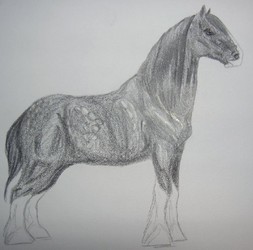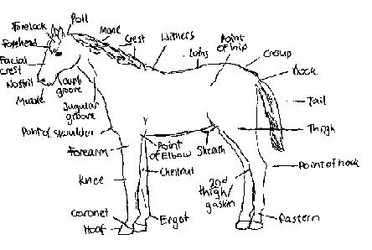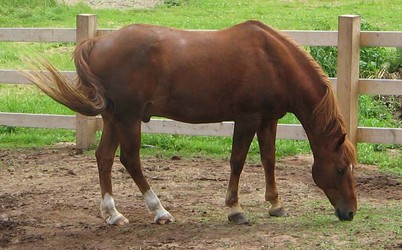Appearance:
Although horses have been selectively bred for centuries by humans and their size and weight varies greatly from breed to breed, their general body pattern remains the same. The horse is a hoofed mammal with four long limbs and a barrel-shaped body. It has a long neck that supports a large, long head, and the eyes and ears are large. The tail is short but covered with long, coarse hairs that extend its length. Long hair also grows along the top ridge of the neck. These hairs can be many different colours, as can the horse's coat: brown, black, grey, spotted, or a combination of two different colours.
Specific Habitat:
A horse can adapt to live in many different environments and climates. This is demonstrated by many breeds of horse living in the wild, which have evolved with special traits. However, in general, a horse needs shelter, food, and open space. Shelter could come in the form of a manmade building, or from something natural like a grove of trees or a cliff. Many horses live on large, flat plains, like the Russian steppes, or the North American prairies. Here there is shelter and space, as well as abundant food (grass).
Adaptations to Environment:
The horse’s survival mechanism is to identify danger and flee from it, rather than fight – although a cornered horse will sometimes fight to defend a foal. The horse’s long neck enables it to eat short grasses without lying down and also to raise its head high to improve its range of vision as it looks for danger. Its eyes are set in the sides of the head for increased all-around vision. Horses have large nostrils to smell danger, large ears to hear everything around it, and large eyes that detect movement very well.
History of the Horse:
Since horses can live in many diverse environments, they have all evolved in many different ways. The earliest ancestor of the modern horse (Hyracotherium), which lived around 60 million years ago, was a small animal with paws, which browsed and ate shrubs and leaves growing low to the ground. Hyracotherium had four toes on its front paws, and three on its back. Due to climatic changes, the vegetation changed as well, and so the soft foliage became much tougher, and plants began to grow taller. So, their teeth changed to be molars more suited to the tougher pants. Thus emerged Mesohippus, which was taller and had a longer neck, and also teeth more suitable for both tougher plants, and grazing. Also, the number of toes on each foot had decreased to three. Around 23 million years ago, Mesohippus became Parahippus, which had much longer legs, and teeth adapted to grinding and chewing grass. Then, 17 million years ago, Merychippus, the first animal recognizable as a horse, evolved. These early horses had become adapted to running, and also had their weight carried only on their middle toes. Thus, the two other toes began to recede, and the middle toe became what we see today as the hoof. Eventually, around 4 million years ago, Equus evolved. Now there are hundreds of different breeds of Equus all over the world, each one slightly different. Many of these have been through the process of artificial selection by humans, and have been bred to perform specific tasks, such as pull heavy loads, jump high obstacles, or gallop exceedingly fast. However, other natural changes have occurred within the different breeds, such as growing a thicker coat during cold seasons, or having tougher hooves than usual for rocky terrain. However, for the general habitat of a flat grassy plain, the horse has evolved over millions of years by elongating its legs, altering its molars, and developing hooves.
Reproductive Characteristics:
The horse reproduces sexually. Because the horse avoids danger by running, every aspect of its reproductive cycle happens quickly. Horses usually breed during late spring, summer, and early fall to ensure that the foal is born during spring, when the weather is warming and the grass is plentiful. Mares (mature female horses) carry their foals for 11 months. The mating process happens very quickly, as does the birth. Mares like to find a marshy, hidden area in which to give birth, presumably to hide from predators. Foals are born fully developed, can stand within 15-25 minutes of birth and can run with the herd when they are one day old. This ensures that the foal will not be vulnerable to predators – a horse that could not run would be at a great risk of being killed. Also, the mare feeds her foal with milk from her own body.
Phylogenetic Tree Classification:
Equus. (Other members of this group are: Zebras, Asses, Donkeys, and Onagers. Horses are also closely related to Tapirs and Rhinoceroses.) The horse is a mammal, and a vertebrate. Under the phylogenetic tree, which classifies life according to its evolutionary history, the horse is included in the Animals branch of the Eukarya domain.



Equus caballus. © 2006 horses1horses1
Importance to Ecosystem:
The horse is a herbivore. Thus, it serves as a consumer of plants, keeping plant populations in check, and sometimes competing with other grazers such as deer and domestic cattle. In the wild, horses are prey to whatever large carnivore inhabits their region – usually wolves or large cats. In cases where a horse cannot run from danger, it will try to defend itself by kicking out with its hooves or biting.
Status:
Though the rise of machinery has meant less work for the horse now than in the past, it is still kept worldwide - as a working or transportation animal in places where horses are more practical to use than machines, or as a recreation animal for things like sport and entertainment. The wild or feral horse is much less common – all animals living in the wild now are feral, semi-feral, or have been reintroduced to the area in which they live. Breeds such as the Exmoor pony of Great Britain run free but are carefully monitored and kept free from the influence of other breeds in an effort to preserve the breed’s characteristics. Much effort is being made to safeguard areas where horses roam free, and to keep the horse from disappearing altogether in the wild. Fortunately, horses are still widely ridden and raised for pleasure purposes, and so the domestic horse, at least, is not in danger of becoming endangered any time soon.
Learning Summary:
The domestic horse has been used by humans for food, recreation, and work for thousands of years, and is still used today. It is one of the only species whose evolution has been strongly influenced by humans for hundreds of years. Thus, it is interesting, because modern horses still have instincts, characteristics, and behaviours that have been passed down from their wild ancestors. Through this treehouse, we hope we have been able to enlighten you about the more 'scientific' side of the glorious animal which is the horse.
Further Reading:
1. http://www.ansi.okstate.edu/breeds/horses/
Click here if you want to learn more about specific breeds of horses! The toolbar at the left directs you to whichever breed you want to look at.
2. http://chem.tufts.edu/science/evolution/HorseEvolution.htm
Click here to see how horses evolved, and how skeletons have changed over 55 million years!
3. http://www.deannesweb.com/horses/horsecolors/index.html
Here is a website where you can learn about the different colors of horses, and afterwards, you can test your extensive knowledge about this topic.






 Go to quick links
Go to quick search
Go to navigation for this section of the ToL site
Go to detailed links for the ToL site
Go to quick links
Go to quick search
Go to navigation for this section of the ToL site
Go to detailed links for the ToL site